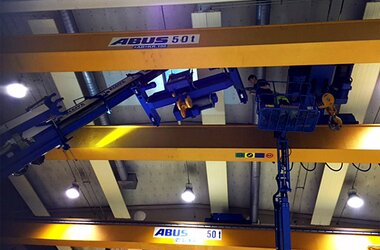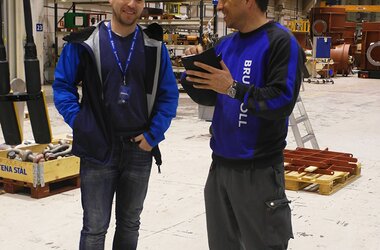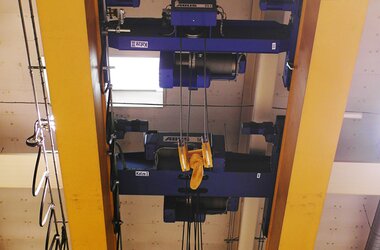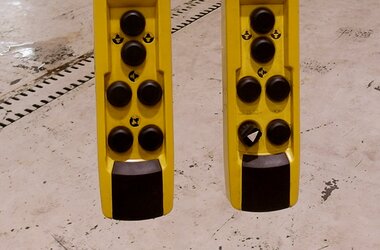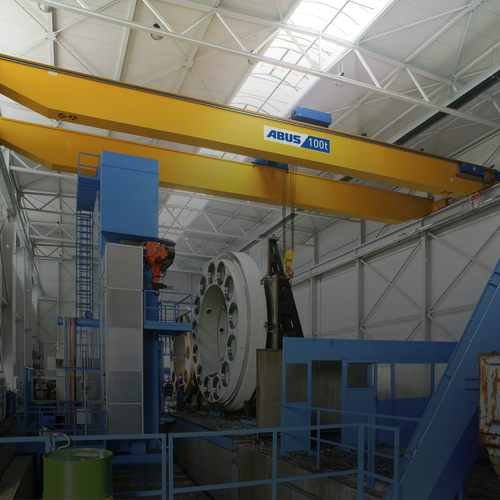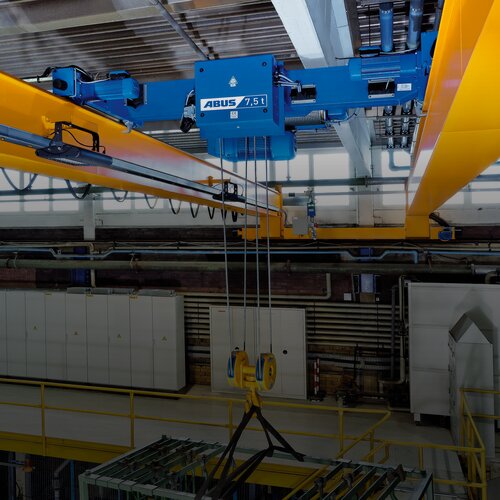Brunvoll in Norway has ABUS crane retrofitted with second hoist
The Norwegian company Brunvoll A/S (www.brunvoll.no) at Molde on the west coast of Norway is steeped in tradition: in their own company-owned museum they can look back on well over one hundred years of eventful company history. Today Brunvoll A/S is one of the world leaders in the sphere of propulsion and manoeuvring of shipping vessels. The past ten years have seen Brunvoll investing quite heavily in the development of staff competence and the improvement of production plants and systems.
Brunvoll have come quite some way to reach world leadership: in 1912 brothers Andreas and Anders Brunvoll founded the Brødr. Brunvoll Motorfabrikk. The company started producing low-pressure diesel engines at first and controllable propellers for fishing vessels. These were sold very successfully in Norway until the sixties and increasingly also in other countries as they were characterised by robust and innovative design: Brunvoll was one of the first motor producers to use roller bearings on the crankshaft. In 1965 came an important turning point in the company’s history. Since the early sixties high-speed diesel engines had become favourites in the shipbuilding industries and now the time for reorientation of the company had come for Brunvoll. In close cooperation with local fishermen the idea was born to equip fishing vessels with tunnel thrusters. Brunvoll put the idea into practice and designed the first tunnel thrusters. In the following years they developed several patented systems for the propulsion and manoeuvring of shipping vessels. Today the company Brunvoll continues to make inroads into new industries and areas of application for their systems, for example equipping service vessels for offshore wind farms with their patented tunnel thrusters.
The continuous development of the company and their products in connection with the expansion and the optimisation of Brunvoll’s production plants are putting high pressure on the machinery used and on the production resources. The highest possible flexibility to adapt to new tasks is required and the ABUS EOT cranes used are no exception. Thus it came to pass that Brunvoll enquired with Industrikran Norge, the Norwegian partner company of ABUS Kransysteme, if it would be possible to have a second hoist retrofitted to one of the existing ABUS double girder cranes ZLK with a span of 21 metres and a stooled-down double rail trolley. This so-called auxiliary hoist—a hoist with lower lifting capacity than the main hoist, in this case 25 tonnes as opposed to 50 tonnes—was supposed to enable loads to be turned during the production process. The go-ahead for retrofitting was given once the required structural analysis of the crane system had been carried out by ABUS Kransysteme in its capacity as manufacturer. The integration of the second hoist, a stooled-down double-rail trolley of the DA type, required the entire electrical system to be modified in order to make load turning possible. The existing hoist was submitted to an inspection and then fitted with a new panel. The crane and the two hoists are now controlled by a so-called double push button pendant. Both hoists feature individual control, i.e. they can be controlled separately by the push button pendant. A load indicator system LIS-SV was also retrofitted and monitors the compliance with load capacity limits of each hoist individually and of the crane system in total.
It took two technical engineers from Industrikran Norge’s service team five days to carry out all retrofitting and modifications including complete rewiring of the system. Last but not least the required new load label “50 t / 25 t” was fitted to the crane indicating the individual lifting capacity of each hoist as well as the total SWL of the crane system.


